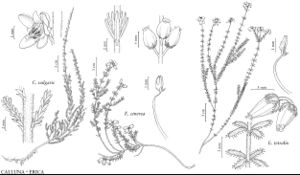Difference between revisions of "Calluna"
Trans. Linn. Soc. London 6: 317. 1802 ,.
FNA>Volume Importer |
FNA>Volume Importer |
Revision as of 23:05, 16 December 2019
Shrubs. Stems erect or ascending, (much-branched); twigs hairy to glabrescent. Leaves persistent, opposite; petiole absent; blade coriaceous, margins spinulose-ciliate. Inflorescences terminal or axillary, racemes or panicles, 5–30-flowered; perulae absent. Flowers bisexual, radially symmetric; sepals 4, distinct; petals 4, barely connate basally, corolla persistent, campanulate; stamens 8, included; anthers with awns, dehiscent by lateral slits; ovary 5-locular, (ovoid); style slightly exserted, straight; stigma capitate. Fruits capsular, globose, dehiscence septifragal. Seeds ca. 5–10, ellipsoid, not winged, not tailed; testa (firm), ± alveolate-reticulate. x = 8.
Distribution
Europe, w Asia.
Discussion
Species 1: introduced; Europe, w Asia.
Species 1
